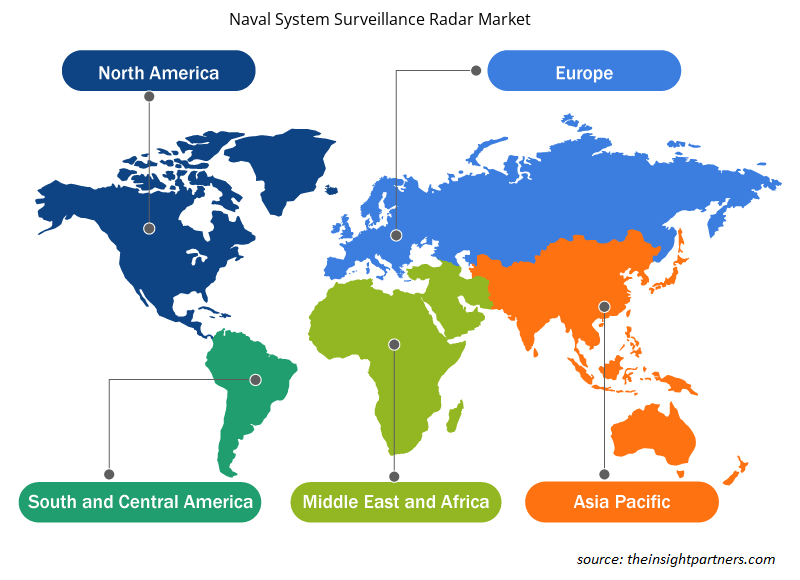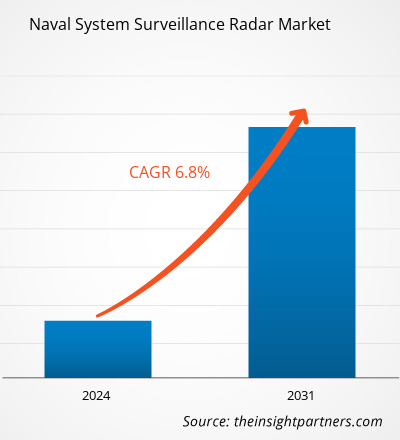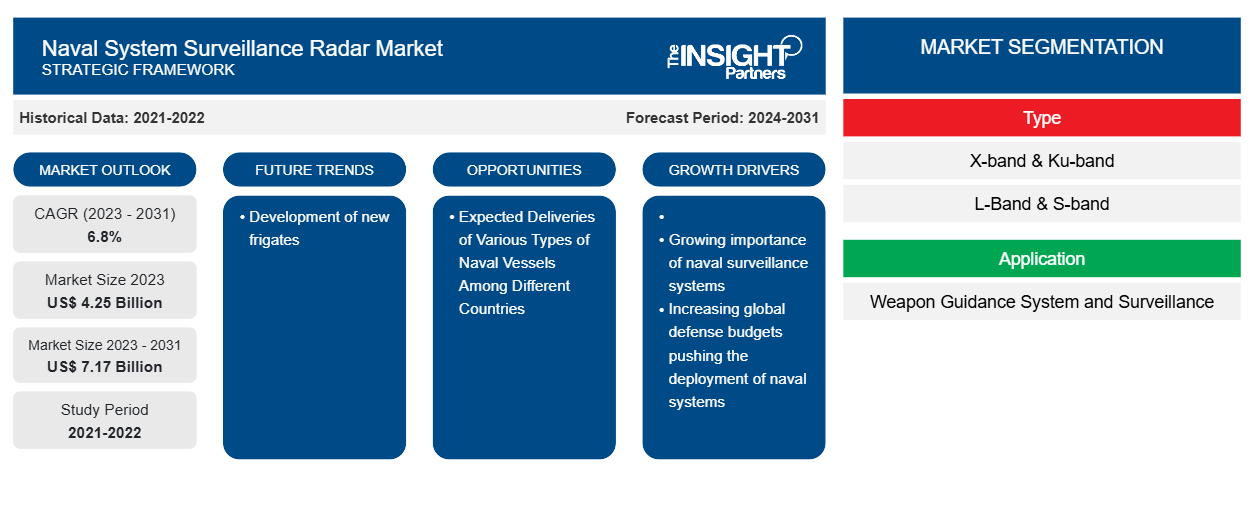Der Markt für Überwachungsradare für Marinesysteme soll von 4,25 Milliarden US-Dollar im Jahr 2023 auf 7,17 Milliarden US-Dollar im Jahr 2031 anwachsen. Der Markt dürfte zwischen 2023 und 2031 eine durchschnittliche jährliche Wachstumsrate von 6,8 % verzeichnen. Die Entwicklung neuer Fregatten dürfte ein wichtiger Trend auf dem Markt bleiben.
Marktanalyse für Marineüberwachungsradare
Radare zur Überwachung von Marinesystemen sind eines der wichtigsten Produkte der Seestreitkräfte für Befehle, Überwachung, Navigation, Marineaufklärung und vieles mehr. Auf dem Markt für Radare zur Überwachung von Marinesystemen besteht eine geringe bis geringe Bedrohung durch Ersatzprodukte. Dies liegt daran, dass die Marinesektoren weltweit nur Radare zur Überwachung von Marinesystemen für Übungen zur nationalen Sicherheit und Navigation beschaffen. Daher ist derzeit auf dem Markt kein vollständiger Ersatz verfügbar. Es gibt jedoch technologische Verbesserungen und Fortschritte. Daher wird erwartet, dass die Auswirkungen der Bedrohung durch Ersatzprodukte auf dem Markt für Radare zur Überwachung von Marinesystemen in den kommenden Jahren gering bleiben werden.
Marktübersicht für Marineüberwachungsradare
Zu den wichtigsten Akteuren im Ökosystem des globalen Marktes für Überwachungsradare für Marinesysteme gehören unter anderem Komponentenhersteller, Hersteller von Überwachungsradaren für Marinesysteme und Endnutzer. Ein Marineradarsystem besteht aus verschiedenen Komponenten, die die Systemhersteller von einer riesigen Basis von Komponentenherstellern beziehen. Diese Komponentenhersteller liefern die Grundteile an die globalen Akteure im Bereich der Überwachungsradare für Marinesysteme. Die Hersteller sind die Unternehmen, die nach der Integration jeder Komponente mit der Herstellung der endgültigen Überwachungsradarsysteme beschäftigt sind. Zu den wichtigsten Akteuren auf dem Markt gehören unter anderem Lockheed Martin Corporation, Northrop Grumman Corporation, Raytheon Technologies Corporation, Saab AB und Thales Group. Zu den Endnutzern des globalen Marktes für Überwachungsradare für Marinesysteme gehören alle Seestreitkräfte auf der ganzen Welt. Die Seestreitkräfte integrieren das Radar unter anderem in U-Boote, Boote, Schiffe und Kriegsschiffe für Anwendungen wie Überwachungs- und Waffenleitsysteme.
Passen Sie diesen Bericht Ihren Anforderungen an
Sie erhalten kostenlos individuelle Anpassungen an jedem Bericht, einschließlich Teilen dieses Berichts oder einer Analyse auf Länderebene, eines Excel-Datenpakets sowie tolle Angebote und Rabatte für Start-ups und Universitäten.
-
Holen Sie sich die wichtigsten Markttrends aus diesem Bericht.Dieses KOSTENLOSE Beispiel umfasst eine Datenanalyse von Markttrends bis hin zu Schätzungen und Prognosen.
Markttreiber und Chancen für Radar zur Marineüberwachung
Steigende globale Verteidigungsbudgets treiben die Stationierung von Marinesystemen voran
Der Anstieg der weltweiten Militärausgaben ist einer der Hauptfaktoren, die die Beschaffung und den Einsatz von Marinesystemen, einschließlich Radaren, in verschiedenen Regionen vorantreiben. So stiegen die weltweiten Militärausgaben laut den vom Stockholmer Friedensforschungsinstitut (SIPRI) veröffentlichten Daten zwischen 2019 und 2022 um rund 8,4 %, was ein starkes Wachstum der Investitionen in Militärtechnologien zeigt . Solche Faktoren haben den Einsatz von Marinesystemen vorangetrieben und damit das Wachstum des Marktes für Überwachungsradare für Marinesysteme vorangetrieben.
Voraussichtliche Auslieferungen verschiedener Typen von Kriegsschiffen in verschiedenen Ländern
Die erwarteten zukünftigen Auslieferungen verschiedener Arten von Kriegsschiffen wie Fregatten, Korvetten, Trägern, U-Booten und Zerstörern werden die Nachfrage nach Radargeräten zur Überwachung von Marinesystemen in den kommenden Jahren in verschiedenen Regionen wahrscheinlich ankurbeln. So verfügten die USA im Jahr 2023 über eine Flotte von rund 243 Kriegsschiffen. Laut der Sekundärforschung von The Insight Partner liegen von den US-Marinestreitkräften bereits Bestellungen im Wert von mehr als 65 Kriegsschiffen vor (darunter 15 Fregatten, 21 Zerstörer, 19 U-Boote, 9 Flugzeugträger und 3 Patrouillenschiffe). Dies wird die Nachfrage nach Neuinstallationen von Radargeräten zur Überwachung von Marinesystemen in den USA weiter steigern. Solche Faktoren werden in den kommenden Jahren wahrscheinlich neue Möglichkeiten für Marktanbieter schaffen.
Segmentierungsanalyse des Marktberichts zur Marinesystemüberwachungsradar
Schlüsselsegmente, die zur Ableitung der Marktanalyse für Überwachungsradare für Marinesysteme beigetragen haben, sind Typ und Anwendung.
- Basierend auf dem Typ ist der Markt für Überwachungsradare für Marinesysteme in X-Band & Ku-Band, L-Band & S-Band und andere unterteilt. Das X-Band- und Ku-Band-Segment hatte im Jahr 2023 einen größeren Marktanteil.
- Basierend auf der Anwendung ist der Markt für Marineüberwachungsradare in Waffenleitsysteme und Überwachung unterteilt. Das Überwachungssegment hatte im Jahr 2023 einen größeren Marktanteil.
Marktanteilsanalyse für Marineüberwachungsradare nach geografischer Lage
Der geografische Umfang des Marktberichts zum Markt für Marineüberwachungsradare ist hauptsächlich in fünf Regionen unterteilt: Nordamerika, Europa, Asien-Pazifik, Naher Osten und Afrika sowie Südamerika.
Nordamerika hat den Markt im Jahr 2023 dominiert, gefolgt von Europa und dem asiatisch-pazifischen Raum. Darüber hinaus wird der asiatisch-pazifische Raum in den kommenden Jahren wahrscheinlich auch die höchste durchschnittliche jährliche Wachstumsrate verzeichnen. Die USA dominierten 2023 den nordamerikanischen Markt für Radarüberwachungssysteme für Marinesysteme. Aufgrund der frühen Einführung der Radartechnologie haben die USA den größten Anteil am nordamerikanischen Markt für Radarüberwachungssysteme für Marinesysteme. Darüber hinaus verfügen die USA über das weltweit höchste Verteidigungsbudget und ein großer Teil des Budgets wird für die Einführung und Beschaffung modernisierter Waffensysteme bereitgestellt. Nach Untersuchungen der Maritime Administration (MARAD) des US-Verkehrsministeriums trägt die Schiffbauindustrie erheblich zum BIP des Landes bei. Der gesamte Haushaltsantrag des Marineministeriums für das Haushaltsjahr 2023 beträgt 230,8 Milliarden US-Dollar, wobei die Marine 180,5 Milliarden US-Dollar und das Marine Corps 50,3 Milliarden US-Dollar erhält. Die Marine beantragt Beschaffungsmittel in Höhe von 53,35 Milliarden US-Dollar, eine Steigerung von 5,4 % gegenüber dem Haushaltsjahr 2023. Dies trägt zur Nachfrage nach Radaren zur Überwachung von Marinesystemen im ganzen Land bei. Die Vereinigten Staaten stehen weltweit an dritter Stelle und verfügen laut Global Firepower über 484 Marineflotten. Die wachsende Flotte der US-Marine ist auch ein unterstützender Faktor für das Wachstum des Marktes für Radare zur Überwachung von Marinesystemen im Land.
Regionale Einblicke in den Markt für Marineüberwachungsradare
Die regionalen Trends und Faktoren, die den Markt für Marineüberwachungsradare im Prognosezeitraum beeinflussen, wurden von den Analysten von Insight Partners ausführlich erläutert. In diesem Abschnitt werden auch die Marktsegmente und die Geografie von Marineüberwachungsradaren in Nordamerika, Europa, im asiatisch-pazifischen Raum, im Nahen Osten und Afrika sowie in Süd- und Mittelamerika erörtert.

- Erhalten Sie regionale Daten zum Markt für Radar zur Marineüberwachung
Umfang des Marktberichts zum Marinesystem-Überwachungsradar
| Berichtsattribut | Details |
|---|---|
| Marktgröße im Jahr 2023 | 4,25 Milliarden US-Dollar |
| Marktgröße bis 2031 | 7,17 Milliarden US-Dollar |
| Globale CAGR (2023 - 2031) | 6,8 % |
| Historische Daten | 2021-2022 |
| Prognosezeitraum | 2024–2031 |
| Abgedeckte Segmente |
Nach Typ
|
| Abgedeckte Regionen und Länder |
Nordamerika
|
| Marktführer und wichtige Unternehmensprofile |
|
Marktteilnehmerdichte: Der Einfluss auf die Geschäftsdynamik
Der Markt für Überwachungsradare für Marinesysteme wächst rasant, angetrieben durch die steigende Nachfrage der Endnutzer aufgrund von Faktoren wie sich entwickelnden Verbraucherpräferenzen, technologischen Fortschritten und einem größeren Bewusstsein für die Vorteile des Produkts. Mit steigender Nachfrage erweitern Unternehmen ihr Angebot, entwickeln Innovationen, um die Bedürfnisse der Verbraucher zu erfüllen, und nutzen neue Trends, was das Marktwachstum weiter ankurbelt.
Die Marktteilnehmerdichte bezieht sich auf die Verteilung von Firmen oder Unternehmen, die in einem bestimmten Markt oder einer bestimmten Branche tätig sind. Sie gibt an, wie viele Wettbewerber (Marktteilnehmer) in einem bestimmten Marktraum im Verhältnis zu seiner Größe oder seinem gesamten Marktwert präsent sind.
Die wichtigsten Unternehmen auf dem Markt für Radargeräte zur Marineüberwachung sind:
- Lockheed Martin Corporation
- Northrop Grumman Corporation
- Raytheon Technologies Corporation
- Saab AB
- Thales-Gruppe
- BAE Systems
Haftungsausschluss : Die oben aufgeführten Unternehmen sind nicht in einer bestimmten Reihenfolge aufgeführt.

- Überblick über die wichtigsten Akteure auf dem Markt für Marineüberwachungsradare
Marktnachrichten und aktuelle Entwicklungen zum Marinesystem-Überwachungsradar
Der Markt für Radarüberwachungssysteme für Marinesysteme wird durch die Erhebung qualitativer und quantitativer Daten nach Primär- und Sekundärforschung bewertet, die wichtige Unternehmensveröffentlichungen, Verbandsdaten und Datenbanken umfasst. Nachfolgend sind einige der Entwicklungen auf dem Markt für Radarüberwachungssysteme für Marinesysteme aufgeführt:
- Die Northrop Grumman Corporation hat einen Auftrag im Wert von 167 Millionen US-Dollar für die Modifizierung der G/ATOR-Radartechnologie der US Navy erhalten. (Quelle: Northrop Grumman Corporation, Pressemitteilung, April 2024)
- Die US Navy stattet 29 neue Schiffe mit dem modernen Marineradar AN/SPY-6 aus und wird dieses System nun auch auf den ersten bestehenden Schiffen installieren. Den Auftakt macht ein 619-Millionen-Dollar-Vertrag mit Raytheon, einem Unternehmen von RTX. (Quelle: Raytheon Technologies Corporation, Pressemitteilung, April 2023)
Marktbericht zum Marineüberwachungsradar – Umfang und Ergebnisse
Der Bericht „Marktgröße und Prognose für Marineüberwachungsradare (2021–2031)“ bietet eine detaillierte Analyse des Marktes, die die folgenden Bereiche abdeckt:
- Marktgröße und Prognose für Marineüberwachungsradare auf globaler, regionaler und Länderebene für alle wichtigen Marktsegmente, die im Rahmen des Berichts abgedeckt sind
- Markttrends und Marktdynamiken für Überwachungsradare für Marinesysteme wie Treiber, Beschränkungen und wichtige Chancen
- Detaillierte Porter-Fünf-Kräfte-Analyse
- Marktanalyse für Überwachungsradare für Marinesysteme, die wichtige Markttrends, globale und regionale Rahmenbedingungen, wichtige Akteure, Vorschriften und aktuelle Marktentwicklungen umfasst
- Branchenlandschaft und Wettbewerbsanalyse, die die Marktkonzentration, Heatmap-Analyse, prominente Akteure und aktuelle Entwicklungen auf dem Markt für Radar zur Marineüberwachung umfasst
- Detaillierte Firmenprofile
- Historische Analyse (2 Jahre), Basisjahr, Prognose (7 Jahre) mit CAGR
- PEST- und SWOT-Analyse
- Marktgröße Wert/Volumen – Global, Regional, Land
- Branchen- und Wettbewerbslandschaft
- Excel-Datensatz
Aktuelle Berichte
Verwandte Berichte
Erfahrungsberichte
Grund zum Kauf
- Fundierte Entscheidungsfindung
- Marktdynamik verstehen
- Wettbewerbsanalyse
- Kundeneinblicke
- Marktprognosen
- Risikominimierung
- Strategische Planung
- Investitionsbegründung
- Identifizierung neuer Märkte
- Verbesserung von Marketingstrategien
- Steigerung der Betriebseffizienz
- Anpassung an regulatorische Trends























 Kostenlose Probe anfordern für - Markt für Überwachungsradare für Marinesysteme
Kostenlose Probe anfordern für - Markt für Überwachungsradare für Marinesysteme